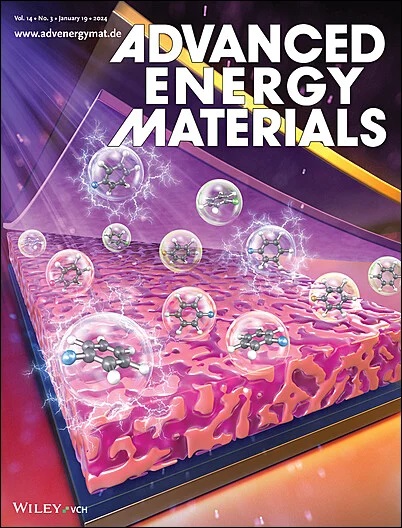Enhancing Long‐Cycle Performance of Zinc Powder Anodes at High Discharge Depths through Comprehensive Electrochemical‐Mechanical Regulation
IF 24.4
1区 材料科学
Q1 CHEMISTRY, PHYSICAL
引用次数: 0
Abstract
Zinc powder anodes hold great potential for developing zinc‐based batteries featuring high Zn utilization. Nevertheless, zinc powder anodes encounter severe cycling instability at elevated depths of discharge (DOD) due to serious ion transfer barriers, parasitic side reactions, and stress‐induced mechanical instability, impeding their practical implementation. Here an electrochemical‐mechanical regulation strategy utilizing the viscoelastic synergy of branched oxygen‐rich oligomers and spherical elastic fillers, achieving significantly improved cycling performance, even under a remarkably high DOD by 96% is proposed. The oligomer's weak zinc coordination effect and expansive free volume facilitate rapid Zn通过电化学-机械综合调控提高高放电深度下锌粉阳极的长周期性能
锌粉阳极在开发高锌利用率的锌基电池方面具有很大的潜力。然而,由于严重的离子转移障碍、寄生副反应和应力诱导的机械不稳定性,锌粉阳极在高放电深度(DOD)时遇到严重的循环不稳定性,阻碍了其实际应用。本文提出了一种电化学-机械调节策略,利用支化富氧低聚物和球形弹性填料的粘弹性协同作用,即使在高达96%的DOD下,也能显著提高循环性能。低聚物的弱锌配位效应和膨胀的自由体积有利于Zn2 +在高DOD下的快速通量,而其醚氧部分通过氢键固定水,动态抑制寄生反应。同时,球形弹性填料通过优异的抗剪切稳定性减轻应力集中,确保机械完整性和在较大体积应变下的连续电接触。这种协同的电化学-机械调节在96% DOD下实现了前所未有的430小时循环性,优于锌阳极。此外,Zn0.25V2O5匹配的全电池在相当低的N/P比(2.51-4.89)下,在200次循环中保持95%-99.7%的容量,突出了它们在高能量、低成本储能方面的潜力。这项工作为在超高利用率条件下稳定金属阳极提供了一个通用的范例。
本文章由计算机程序翻译,如有差异,请以英文原文为准。
求助全文
约1分钟内获得全文
求助全文
来源期刊

Advanced Energy Materials
CHEMISTRY, PHYSICAL-ENERGY & FUELS
CiteScore
41.90
自引率
4.00%
发文量
889
审稿时长
1.4 months
期刊介绍:
Established in 2011, Advanced Energy Materials is an international, interdisciplinary, English-language journal that focuses on materials used in energy harvesting, conversion, and storage. It is regarded as a top-quality journal alongside Advanced Materials, Advanced Functional Materials, and Small.
With a 2022 Impact Factor of 27.8, Advanced Energy Materials is considered a prime source for the best energy-related research. The journal covers a wide range of topics in energy-related research, including organic and inorganic photovoltaics, batteries and supercapacitors, fuel cells, hydrogen generation and storage, thermoelectrics, water splitting and photocatalysis, solar fuels and thermosolar power, magnetocalorics, and piezoelectronics.
The readership of Advanced Energy Materials includes materials scientists, chemists, physicists, and engineers in both academia and industry. The journal is indexed in various databases and collections, such as Advanced Technologies & Aerospace Database, FIZ Karlsruhe, INSPEC (IET), Science Citation Index Expanded, Technology Collection, and Web of Science, among others.
 求助内容:
求助内容: 应助结果提醒方式:
应助结果提醒方式:


